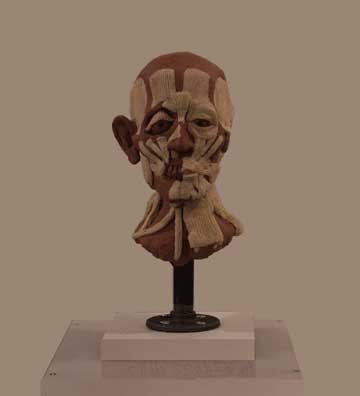Ecorché Portrait Bust

A traditional exercise for art students is the ecorché. The word is French for "flayed" and is a way to study the anatomy by starting off with the bones, then adding muscle, and some even go further placing connective and adipose tissue. Skin can be added but unless done sparingly kind of destroys the point of the exercise.
This sculpture was rendered in oil based clay. A rotating animation can be viewed in a separate window if you just click here.
Ecorché studies began during the Renaissance when artists and physicians began serious anatomical studies by dissecting corpses, a practice that was always permitted except in unusual circumstances. Yes, that's always permitted except in unusual circumstances.
One biggest myths of our modern era - rivaling the myth that everyone thought the world was flat until Columbus made his voyages - is that human dissection was illegal and banned in the Middle Ages and the Renaissance. Not true at all. Autopsies were carried out openly and above board and are documented in Italy as early as 1286. They were no more more forbidden than the normal embalming processes which at that time was simply gutting the body to slow down decay.
In fact, the purposes of the earliest dissections will raise some eyebrows for those who think the "Church" was opposed to hacking up the human body. If an abbot or abbess of a monastery or convent died and was a good candidate for sainthood, the monks or nuns might slice their former leader up and rummage around in the deceased's innards to find some indication that the deceased was a saint. If something quite interesting was found, like an organ with folds that looked like a cross or a kidney stone that looked like the crown of thorns, the congregation would vouch for the "evidence" at the canonization hearings. In one such case, the Pope's criticism was not for the chopping up of the abbess, but his doubt that the nuns really found what they said they did.
We also have records that dissections for teaching, research, and forensic information were carried out well before 1400, once more without any censure or legal prohibitions. In fact, dissections became an extremely popular - and public - form of entertainment. Crowds of up to 500 people would show up at advertised dissections, and temporary bleachers had to be erected. Large buildings - including churches - were used to house the audience.
You will also read or hear that because of the theological doctrine of resurrection of the body, the Church only officially approved of dissecting executed criminals (both male and female). Aside from the fact that the Church made no such ruling, there was the practical problem that the supply of criminals was quite limited. Executions in the Renaissance were far fewer than commonly believed. Florence, for instance, had perhaps 6 to 7 executions per year.
Instead, a far more ready source of cadavers were hospitals where deaths were frequent and a number of the subjects were poor and without family. Once Leonardo Da Vinci was visiting the hospital of Saint Maria Nuova in Florence (still operating - no joke intended - today), and noticed an elderly patient. Leonardo sat down to talk.
Leonardo passed a pleasant time with the old gentleman. The man, who was over a hundred years old, replied there was no pain, just a general weakness. In a few hours and still talking with Leonardo, the man died. Immediately Leonardo had the man taken to the mortuary and cut him up - to find the cause of so sweet a death, he wrote. In doing so he gave us our first accurate description of arteriosclerosis
Some historians believe Michelangelo also performed dissections, although the sculptor left no documentation as his rival Leonardo did (the two men knew and did not like each other). Even if he did not do the dissections himself, Michelangelo's facile draftsmanship would have been a major asset even simply by attending public dissections. We know as a young man he spent three months in Bologna where even to this day the university has a medical school of international reputation.
Probably what confuses a lot of people into believing dissections were banned was what happened when Leonardo was living in Rome. He was not doing much painting at that point but was carrying out scientific experiments, which included studies of anatomy. Suddenly the Pope ordered Leonardo to cease his anatomical studies. Most people think this meant that the Pope was simply enforcing the church policy against dissection.
But the Pope did not ban dissection per se. Instead his order was directed specifically at Leonardo. Evidently Leonardo had been having a professional dispute with a craftsman he had hired to help him prepare mirrors possibly for work on building a solar furnace. The worker (called Giovanni although he was German) evidently spread some kind of rumors to the Pope and at the hospital where Leonardo was conducting his dissections. Some speculate the workman had said Leonardo was practicing sorcery. But a more recent opinion was that Leonardo' studies had led him to believe that an unborn fetus had no soul and so no separate identity before birth. Even at that time, such a belief was against Catholic doctrine, and the most expedient way for the Pope to quash any rumors, whether of sorcery or heresy, was to tell Leonardo to cut it out (once more, no joke intended).
References
"The Criminal and the Saintly Body: Autopsy and Dissection in Renaissance Italy, Katharine Park, Renaissance Quarterly, Vol. 47, No. 1, (1994)
Leonardo da Vinci: Flights of the Mind, Charles Nicholl, Viking (2004)